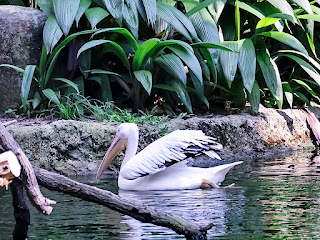HISTORY
This is the type of history the average Singaporean owner would tell the vet. The vet need to ask pertinent questions like vomiting (vomited 2x), polydipsia which is -drinking a lot of water (yes).
PHYSICAL EXAMINATION
Rectal temperature was 38.5C. Normal. Mucous membrane slightly cyanotic and pale.
A large distended abdomen was obvious. An old female dog not spayed. The first diagnosis was closed pyometra. Examine the vulva. A red spot of blood hung out from the vulva gave me the clue.
PALPATION OF ABDOMEN
No pain at all. Pain in the lower 1/3 of the abdomen is said to be present in closed pyometra and the swollen uterus can be palpated. The whole abdomen was just a swollen balloon and so it was difficult to palpate the two internal uterine horns. There seemed to be various swellings, some big. some small.
X-RAYS
X-rays can be done to show the swollen uterine bodies and to increase the income for the practice. A diagnosis of closed pyometra by history and clinical findings will cost the owner less. I did not milk the owner by getting X-rays done to protect myself from litigation. However, I insisted on a blood test to ensure that the dog's kidneys and liver are in good condition since the dog was vomiting. Vomiting could be due to high blood urea or liver disorder from the toxaemia.
BLOOD TEST
An increased white cell count is said to indicate a high bacteria infection. However, a normal white cell count does not mean that the dog has no pyometra as will be discussed in another case. I had blood test done in this case. There was a marked decrease in white cell count. A decrease in platelet count. Blood test is an ancillary aid to diagnosis and should never be relied upon to advise the owner on the closed pyometra case. If the owner wants to save money, I don't insist on a blood test but would advise the owner that he had been informed.
DIAGNOSIS
What is the instant diagnosis? Normal temperature and no fever. A drop of bright red bloody vaginal discharge. Just not eating much or not eating for 2 days. But there is polydipsia, polyuria and vomiting.
BE BRUTALLY FRANK ABOUT THE PROGNOSIS.
Due to the tendency of a few Singaporeans to complain and be litigious when outcomes are not to their satisfaction, I am nowadays brutally frank to dog owners when their dog's lives are in danger. Cut to the chase. I said to the son, "Your dog has a very serious womb infection. She will die within 2 days if you don't operate. If you operate she may die on the operating table as she is very old. Had you got her spayed when she was young, you would not have this worry."
"What are the chances of survival?" the son asked.
"50:50," I estimated. "If you permit her to be operated soon. Not wait till tomorrow."
"So low?"
"For most dogs in the same age group, I give less than 50%," I said. "Your dog is in good condition and not skinny. She has no fever and was sick only '2 days'. She has no heart disease but I don't know about the liver and kidneys." This dog looked well fed and could be considered a bit on the plump side. But since she collapsed yesterday and could not stand up, this was a warning sign not to give optimistic predictions. Blood test show toxaemia and yet this dog had a normal rectal temperature and looked bright. Most owners are worried about the poor chances of survival. So they delayed surgery or took their dog to another vet for another opinion and costing. This is OK if the dog is not in a toxic stage but who can tell?
TWO CHOICES?
"So, we have 2 choices," the son said. "To operate and not to operate."
PROPER COMMUNICATION IS IMPORTANT
"You have no choice," I said. "Your dog is going to die if you don't get her operated. Your mum may be seeing this dog for the last time before I operate today. It is very important I do it today as the womb is very swollen with toxic pus.
EMERGENCY SURGERY
In this case, I operated within one hour after giving her an IV drip. The dog ate the next day and is normal as at day 3 when I write this report. Soon, she would be going home. The surgery is illustrated in pictures below.

"Why you said the uterus is going to rupture soon?" the young intern asked me. It is good to ask why. The browning of the uterine walls indicated cellular necrosis and death. Within 2-4 days, the uterus would rupture leaking out pus and killing off the dog. If the owner procrastinated, don't blame the vet. The vet must give a letter of advice to protect himself or herself against frivolous complaints, should the owner want the dog discharged to seek a second opinion and the dog dies at the 2nd vet.
EARLY DETECTION, DECISIVENESS OF THE OWNER AND TRUST IN THE VET'S DIAGNOSIS AND SURGICAL COMPETENCE. A happy outcome in this case was not due to luck. When old dogs survive a toxic closed pyometra, surgery, it is not a matter of luck. It is knowing the fundamentals and the technicals of the diagnosis of closed pyometra, the anaesthesia, surgery and IV support and in excellent communications with the owner.
More pictures at www.toapayohvets.com DOGS OR
goto: http://www.bekindtopets.com/dogs/20100416closed_pyometra_old_maltese_toapayohvets.htm




